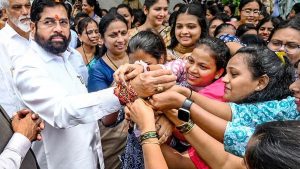Assam’s Family Size Norm For New Initiative Could Hit Its Marginalised Women Most
Linking economic welfare schemes for women to their family size will further limit women’s participation in work and increase their vulnerabilities, argue experts

The family-size norm mandated by the Assam government for its new financial initiative to help rural women entrepreneurs could end up penalising marginalised women who have little control over reproductive decisions, as studies have established.
Last Friday, the Assam government announced the Mukhyamantri Mahila Udyamita Abhiyaan (MMUA) which aims to provide almost 4 million women who are members of self help groups (SHG) a minimum annual income of Rs 1 Lakh each. But the scheme comes with a catch. It excludes women from general and OBC categories who have more than three children. The limit for Scheduled Castes and Tribes is four children.
The rationale for this condition, Assam Chief Minister Hemanta Biswa Sarma said is this: “If a woman has four children, where will she get the time to spend the money, where will she get the time to do business? She will be busy with making the children study.”
This move follows the Assam government’s 2019 decision to render those with more than two children ineligible for government jobs January 2021 onwards. This was part of the Population and Women Empowerment Policy of Assam passed by the Assembly in 2017. Chief Minister Biswa Sarma had then stated that similar population norms will dictate future state welfare schemes.
The family size norm for beneficiaries of public schemes is not new to India. At least 13 Indian states have implemented a two-child policy, either as a criteria for participating in local body elections or for availing public welfare schemes.
However, Gita Bhattarcharya, an Assam-based gender activist says such policies are not only deeply misogynistic, but also communally polarising. “Sarma’s insensitive remarks not only puts the burden of child care on women, it is also a veiled attack on the women of Muslim-majority areas, especially the char-chapori areas. Sarma has even said on record that he plans to form a ‘population army’ to curb birth rates in these regions,” says Bhattacharya. (Chars are densely populated sandbars in the middle of the Brahmaputra river, while chaporis are low-lying flood prone riverbanks. Both terms are used interchangeably — a char can become a chapori, and vice versa depending on the state of the river currents. Assam’s Kamrup, Dhubri, Barpeta, Goalpara, and Darrang districts fall in this region. In this Muslim-majority region, 80% of people live below the poverty line, according to government figures.)
Marginalising The Marginalised
Assam’s total fertility rate (TFR) – the average number of children born per woman – is 1.9%, below the national average of 2, according to NFHS-5 figures. Further, it shows that 77% of women who are currently married and 63% of men aged 15-49 years in Assam want no more children, are already sterilised, or have a spouse who is sterilised. “Sarma statements tie in with his larger xenophobic sentiments and fear-mongering that Bengali Muslims will take Assamese people’s jobs and lands,” says Bhattacharya.
However, Bhargabi Das, assistant professor at the School of Humanities and Social Sciences Department of Rural Management at Shiv Nadar University, argues that it is not untrue that char-chapori areas in Assam have a higher fertility rate but that the CM’s interpretation of this is still problematic.
Assam’s under-five mortality rate – the number of children under the age of five years dying per thousand live births – is 56, higher than the national average of 50. In the chars, the number, according to a recent study, is more than double at 136.9. The fertility rate in the areas surveyed was also found to be higher than the state average. “But it is due to a lot of factors like lack of education, access to healthcare, sanitation, and widespread poverty. Instead of addressing that, the Assam government is running a campaign of maligning the population in these communities as well as marginalising the already marginalised,” says Das.
Tauhida Begum, (45) from Hatigaon, Guwahati is an education volunteer with Assam’s Sarva Shiksha Abhiyan (SSA), and has two children. She says that the initiative will only hurt women, especially from marginalised sections. “The government has no right to make these conditions especially at a time when unemployment is so high in the state.”
In Assam according to the latest Labour Force Participation Rates (LFPS) figures, the overall unemployment rate for women stands at 12%, higher than the national average of 10.6%. Begum who earns Rs 6500 per month is a contractual worker, and she has not been paid for the last few months. It was only after protests that the state government released their wages. Her wage has not increased in the last 10 years.
There has also been widespread resistance against such moves in Assam, with experts and civil society groups echoing various concerns. Population control measures, particularly those that are linked to incentives/disincentives, violate the International Conference on Population and Development Programme of Action (ICPD POA) from 1994, a pact signed by India and the National Population Policy (NPP) of 2000. Both frameworks stress the centrality of individuals’ informed choice and consent.
Also, the enforcement of a two-child norm clashes with various constitutional provisions, say experts: Articles 14 and 15, ensuring equality before the law, Articles 39A and 46 safeguarding the rights of the disabled and marginalised, and Article 51(A), discouraging practices derogatory to the dignity of women.
Exclusion of Marginalised Women
As we have reported earlier here, population control measures are notorious for their disproportionate impact on women especially from marginalised communities. We cited studies by the government (2009) and researchers like Nirmala Buch (2005) which show that the two-child norm has led to a high proportion of disqualification among women and marginalised social groups. Both studies reveal that 80% of disqualified candidates belonged to SC, ST and OBC communities. Women constituted 41% of disqualification cases of elected representatives across 5 states in the study conducted by Buch.
In the case of the recent Assam initiative, such conditionalities will also limit the participation of women from SHGs , says Das. “One way of empowering these women was having SHGs which are not just about finance, but also safe community spaces for women. These are also spaces where fieldworkers and medical teams go and have conversations with women which can’t happen when there are men around. They will lose out on spaces where they can have solidarities,” she adds.
Implications for Women’s Health
Monjuwara Mullah, (38) a resident of Barpeta, who runs a co-operative society of women artisan workers, half of which comprises Bengali Muslim women, says that tying population control measures with women’s access to financial assistance will disproportionately affect those with little control over the number of children they bear.
“In char-chapori areas, most women have more than two children. And this number is not dictated by their wishes – most women here, who are domestic workers, or do farm work have no control over their bodies. Further, they have no knowledge of their reproductive rights or any awareness on what contraception to take. Heikhini mohila lahe lahe etiya aag bahi ase, kintu hothathkoi enekua decision tu mohila hokuluko’r uporot beya probhab pelabo (women who are breaking out of their marginalities, will be pushed further back in),” says Mullah.
Das, who has worked with the women in the char areas of Barpeta district in Assam, calls the state is blind to this ground reality. “Not only is there lack of awareness, many women are also actively discouraged by the religious clerics from using contraception. Even when ASHA workers come to counsel them, it is only oral contraceptives that they are interested in taking because their husbands don’t wear condoms. So while the actual burden of family planning falls on women, it is the state, which is deeply patriarchal, and the family, which is also patriarchal, that call the shots,” she says.
One of the repercussions of such policies is also the desperation to circumvent their rules, notes Mary John, professor at the Centre for Women’s Development Studies. “It will encourage more women to opt for sex-selection because when you are being pushed to have, say, only two children, and you already have a girl child, then the sex of that child becomes all the more important,” says John.
Buch’s study that looked at five states in India, shows that sex-selective and unsafe abortions increased in those states that adopted the two-child policy. The move also saw men divorcing their wives to run for local body elections and families giving up children for adoption to avoid disqualification.
‘Structural Changes First’
The women associated with Mullah’s cooperative society who work on tailoring and kantha embroidery work have gained some degree of financial independence. “Aami mohila burok kiman kou, domestic violence hole police’k inform koribole, horute baccha biya nidibo, family planning koribo, kintu eibur mukhor kotha he – tar pora uluar loge loge heikhini akou hoye. Sorkare family planning kora aagote, rights’r uporot kaam koribo lagibo (we counsel women on various issues – from domestic violence, to child marriage to family planning. But counselling doesn’t work if we don’t address the fundamental problems at play. Before family planning, the government needs to focus on women’s access to rights),” she points out.
Sushila Sarkar (36), a domestic worker from Guwahati’s Christian basti and a part of an 15-member SHG group in her locality says that she is happy that the government is providing incentives based on the number of offspring. She belongs to an SC group, has three daughters, and her husband is a daily-wage earner. She can avail the scheme as per the guidelines of the scheme but she does not have a caste certificate.
“Neither I, nor my husband and three daughters have been able to get a caste certificate. Both of us are always working and have no time to go to seek it, nor do we know how to get one,” says Sarkar.
Mohan Rao, who has written extensively on the effects of population control measures writes in EPW that such norms police people instead of investing in welfare programmes: “The problem with these punitive approaches is both fundamental and pragmatic. Fundamentally, it represents a profound misunderstanding of the relationship between population and development. States that have successfully achieved demographic transition have done so by investing in social welfare programmes, not by manipulating fertility. In other words, population is the dependent variable, not the other way around.”
We believe everyone deserves equal access to accurate news. Support from our readers enables us to keep our journalism open and free for everyone, all over the world.




